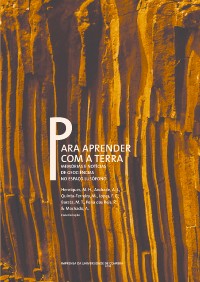Please use this identifier to cite or link to this item:
https://hdl.handle.net/10316.2/31400| DC Field | Value | Language |
|---|---|---|
| dc.contributor.author | Barreto, A. M. F. | |
| dc.contributor.author | Brilha, J. B. R. | |
| dc.contributor.author | Sales, A. M. F. | |
| dc.contributor.author | Almeida, J. A. C. de | |
| dc.date.accessioned | 2014-06-19T16:03:07Z | |
| dc.date.accessioned | 2020-09-18T16:45:33Z | - |
| dc.date.available | 2014-06-19T16:03:07Z | |
| dc.date.available | 2020-09-18T16:45:33Z | - |
| dc.date.issued | 2012 | - |
| dc.identifier.isbn | 978-989-26-0533-3 (PDF) | |
| dc.identifier.uri | https://hdl.handle.net/10316.2/31400 | - |
| dc.description.abstract | The Santana Formation outcrops on the flanks of the Chapada do Araripe in three states of northeastern Brazil, southern Ceará, west Pernambuco and east Piauí. Their fossils, preserved in concretions, are the most important of the Lower Cretaceous of Gondwana. This paper aims to present the inventory and actions for the preservation and safeguarding of such heritage in the states of Pernambuco and Piauí, where Santana Formation has a thick layer of gypsum, representing about 85% of the Brazilian production of gypsum, underlying strata with fossiliferous concretions. Among the 21 studied fossil outcrops, 5 geosites were selected due to its high scientific and educational importance. Twenty‑one gypsum mining companies were also visited to assess their potential palaeontological value and possible involvement of owners in the preservation of this heritage. Concerning valuation actions, a leaflet alerting for the need to conserve fossils was prepared for dissemination to the general public, together with a didactical book for schools. The establishment of a partnership between the Federal University of Pernambuco and local colleges is also expected to occur. We intend to promote the involvement of the community donating fossils for the creation of local museums, together with the participation of local administration, colleges, and businesses, fostering the protection of the palaeontological heritage. | eng |
| dc.description.abstract | A Formação Santana aflora nos flancos da Chapada do Araripe em três estados do nordeste brasileiro, no sul do Ceará, oeste de Pernambuco e leste do Piauí. Os seus fósseis, preservados em concreções, são dos mais importantes do Cretáceo Inferior do Gondwana. O presente trabalho tem como objetivo apresentar inventário e ações para a preservação e salvaguarda desse patrimônio nos estados de Pernambuco e Piauí, onde a formação tem uma espessa camada de gipsita, cuja exploração representa cerca de 85% da produção brasileira de gesso, subjacente aos estratos com as concreções fossilíferas. Foram estudados 21 afloramentos fossilíferos, tendo sido 5 selecionados pela relevância científica e didática. Também foram visitadas 21 empresas de mineração de gipsita para avaliar o potencial fossilífero e interesse dos empresários em colaborar na preservação desse patrimônio. Quanto as ações de valorização, está sendo elaborado um texto de divulgação para o público em geral e livro paradidático, simultaneamente com o estabelecimento de um convênio entre a Universidade Federal de Pernambuco e faculdades locais. Propõe‑se, ainda, o envolvimento da comunidade na doação de fósseis para a criação de museus locais, bem como a participação do poder público, faculdades, empresários e comércio, no gerenciamento e proteção do patrimônio paleontológico. | por |
| dc.language.iso | por | - |
| dc.publisher | Imprensa da Universidade de Coimbra | por |
| dc.relation.ispartof | http://hdl.handle.net/10316.2/24405 | por |
| dc.rights | open access | - |
| dc.subject | Palaentological heritage | eng |
| dc.subject | Inventory | eng |
| dc.subject | Protection actions | eng |
| dc.subject | Araripe | eng |
| dc.subject | Santana Formation (Brazil) | eng |
| dc.subject | Patrimônio fossilífero | por |
| dc.subject | Inventário | por |
| dc.subject | Ações de proteção | por |
| dc.subject | Araripe | por |
| dc.subject | Formação Santana (Brasil) | por |
| dc.title | Patrimônio paleontológico e geoconservação da Formação Santana (Cretáceo Inferior da Bacia do Araripe, Pernambuco e Piauí: Nordeste do Brasil) | por |
| dc.title.alternative | Geoconservation and palaeontological heritage of Santana Formation (Lower Cretaceous, Araripe Basin, Pernambuco e Piauí: Northeaster Brazil) | eng |
| dc.type | bookPart | por |
| uc.publication.firstPage | 311 | - |
| uc.publication.lastPage | 319 | - |
| uc.publication.location | Coimbra | por |
| dc.identifier.doi | 10.14195/978-989-26-0533-3_33 | - |
| uc.publication.digCollection | PB | por |
| uc.publication.orderno | 33 | - |
| uc.publication.area | Ciências Naturais | por |
| uc.publication.bookTitle | Para aprender com a Terra: memórias e notícias de Geociências no espaço lusófono | - |
| uc.publication.manifest | https://dl.uc.pt/json/iiif/10316.2/31400/218705/manifest?manifest=/json/iiif/10316.2/31400/218705/manifest | - |
| uc.publication.thumbnail | https://dl.uc.pt/retrieve/11295926 | - |
| uc.publication.parentItemId | 52123 | - |
| uc.itemId | 71883 | - |
| item.grantfulltext | open | - |
| item.fulltext | With Fulltext | - |
| Appears in Collections: | Para aprender com a Terra: memórias e notícias de Geociências no espaço lusófono | |
Files in This Item:
| File | Description | Size | Format | |
|---|---|---|---|---|
| 33-para_aprender_com_a_terra_v.f..pdf | 635.42 kB | Adobe PDF |  |
Items in DSpace are protected by copyright, with all rights reserved, unless otherwise indicated.
